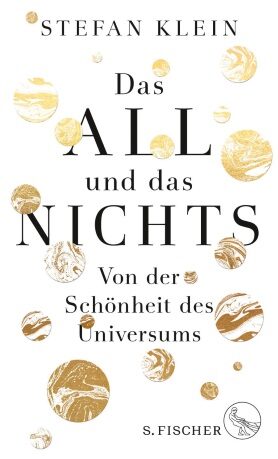Stefan Klein
Das All und das Nichts. Von der Schönheit des Universums
[Space and the Void. On the Beauty of the Universe]
- S. Fischer Verlag
- Frankfurt am Main 2017
- ISBN 978-3-103-97261-0
- 239 Pages
- Publisher’s contact details
Sample translations
A Guide to Amazement: Stefan Klein gives a tour through the secrets of the universe
The physicist and well-known author Stefan Klein has already written about topics including luck, chance and time. In his new book, he tackles some of the most captivating and least understood phenomena in the universe. Readers soon realize that we will not run out of secrets any time soon. Every time science finds an answer, three new questions appear at the very least.
Researchers today can measure the temperature of the background radiation throughout the universe down the millionth of a degree and conclude from the radiation’s pattern that the universe is currently expanding at more than the speed of light. Nonetheless, the universe is not infinite – something evident, Klein explains, in the fact that it’s dark at night. If there were an infinite number of stars, they would pack the nighttime sky and it would be light. On the other hand, there are realms beyond the visible universe we will never perceive because they are receding faster than their light can get to us. The more we know about relations of things in our universe, Klein concludes, the more mysterious it appears.
Klein’s book presupposes no knowledge on the part of readers. The author begins each chapter with questions he asked his own parents as a child (what is light?) or brief historical flashbacks. For example, Klein explains the Theory of Relativity by invoking a question asked by the 15-year-old Einstein (what is it like to ride on a beam of light?) and elucidates quantum entanglement by using the example of a detective novel.
To explicate the possibilities and boundaries of science, Klein uses earthly phenomena like the weather. Why is it that we still cannot predict the weather with absolute accuracy? Because a huge number of factors exert an influence that aren’t measured precisely enough or adequately accounted for in model calculations. On the other hand, nature allows us deep insight into its laws, while on the other it doesn’t allow us to understand how it works as a whole. We will never be able to predict the twists and turns of love, our thoughts and the thronging of an anthill.
Knowledge about the universe isn’t always of direct, practical use. Instead it tells us fundamental things about the world we live in. One example is the Higgs boson, or Higgs particle, which in reality is not a particle but a field from which particles moving through it draw their mass. Without it our universe would not exist. It cost more than ten billion dollars to find the Higgs boson, Klein reports, leaving readers to decide whether this was a worthwhile investment.
For a writer of non-fiction, Klein has an astonishingly poetic vein. It is almost as though the universe knew we were coming, he writes at one point. We owe our existence to a mood of nothingness, he proposes elsewhere. This book will increase the amazement with which readers gaze into the nighttime sky.
Translated by Jefferson Chase

By Manuela Lenzen
Manuela Lenzen is a freelance science journalist. The main subject areas of her writing are evolution, cognition, and artificial intelligence.
Publisher's Summary
Why the world is not as it appears – amazing stories about space and time from best-selling author Stefan Klein
Does the void exist? Are space and time just an illusion? Are our minds capable of conceiving space at all? And why are we even on earth? 21st-century physics changes our perspective of the world and ourselves. Stefan Klein relates this in his gripping and at the same time poetic book. Beginning with the blossom of a rose, he traces the beauty of the unknown, when examining the weather; he explains the unpredictability of the world, and by using a crime story, he helps us visualize the true form of space. With great literary feeling, Stefan Klein makes us marvel and takes us on a journey to our reality that is quite different from the way we perceive it.
(Text: S. Fischer Verlag)
